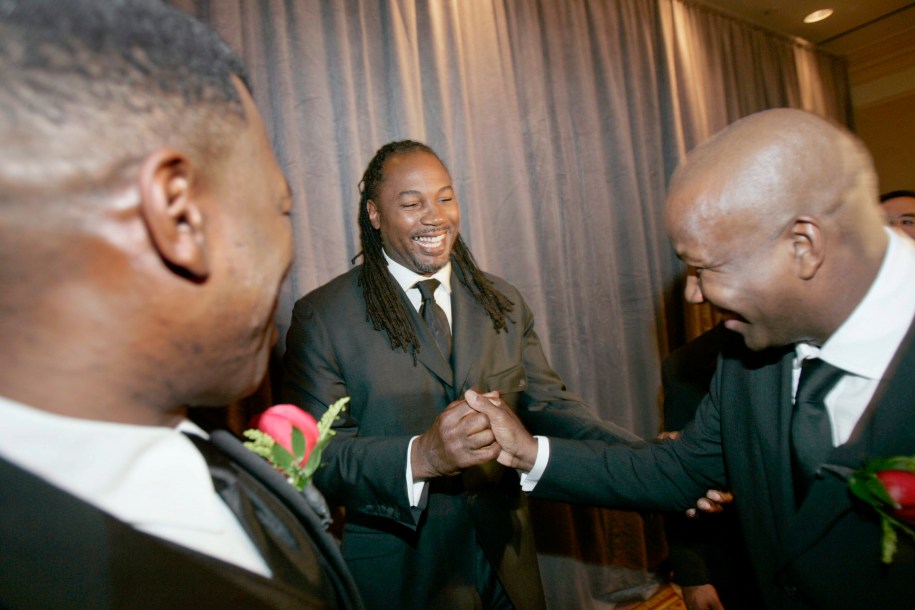Legendary Olympians Abound at Hall of Fame Ceremony
Thanks to some of the country’s most recognizable Olympians, Canada’s Sports Hall of Fame just got a big boost in the “fame” department. Inducted on November 5th were some of Canada’s greatest athletes and sport builders.
Each one helped Canada make tremendous strides in athletics, baseball, boxing, figure skating, hockey, speed skating and swimming.
First to the ring. Over a 23-year boxing career, Lennox Lewis defeated his biggest rivals on the way to becoming heavyweight champion of the world – a title he held upon retirement in 2004. He beat the likes of Mike Tyson and Evander Holyfield, but he started first as a Canadian Olympian two decades ago.
Lewis said boxing at the Olympic Games rank “at the top” of his career accomplishments. “Because without them, the other ones wouldn’t be possible,” he said. “It was the start, a ticket into the professionals.”
At 18, he travelled to Los Angeles for the 1984 Olympic Games. There he finished fifth, losing in the quarterfinal to eventual champion Tyrell Biggs. His shining moment came in Seoul four years later, when Lewis knocked out Riddick Bowe to win the gold medal. It was Canada’s first Olympic boxing title since 1932.
“It’s a great honour to be selected to the Hall of Fame,” Lewis said. “They talk about the American dream, but there is a Canadian dream too … Everything is possible as long as you dedicate and work hard.”
Next to the ice. Speed skater Marc Gagnon’s five medals make him the second most-decorated Olympian in Canadian history. On the short track, he has three gold and two bronze medals stretching from 1994 to 2002, as well as numerous others at World Championships. Gagnon remains one of the most modest sport legends one is bound to meet.
“I don’t think it means anything being me,” he said. “It means the most to be an inspiration to others. If people like me can inspire people to do a little more sports and move around a little more, have a better life, then I will be happy about that.”
Next to the track, to a group of athletes whose amazing 1996 performance Gagnon credited with being an inspiration to his own performances. Theirs is a race of lore in Canada. Donovan Bailey, Glenroy Gilbert, Bruny Surin, Robert Esmie and Carlton Chambers (alternate) formed a gold medal 4x100m relay team who upset the favoured Americans on their home turf. They were the No. 1 relay team in the world for six years, one of the best Canadian teams ever, of any kind.
Surin said as a fledgling track athlete, people told him he couldn’t make it far, but he didn’t allow it to dispirit him. “When I (speak to) kids, I tell them it’s important to have dreams, to dream in color,” he said. “The relay team you see today, it was a team effort. What made the difference is the team spirit, the trust between all five here to win the gold medal.”
Bailey alluded to “tough times in the bunker” on to the road to gold, teammates pushing themselves and their limits. Inducted into the Canadian Olympic Hall of Fame in 2004, the team now enters Canada’s Sports Hall of Fame.
One of Canada’s greatest hockey players joined his fellow Olympians in the induction ceremony. Steve Yzerman, famed Detroit Red Wing No. 17, sits in sixth spot on the NHL’s all-time points list with 1,755. He was twice an Olympian. After the team finished a disappointing fourth at the 1998 Olympic Winter Games, they rebounded to capture gold in Salt Lake City in 2002.
“There is great emotion, more emotion (than playing professionally) in representing your country,” said Yzerman, who is the general manager of the men’s team for 2010.
On being inducted: “This is a very special honour for me. I’m a tremendous sports fan and I always take note of Canadian athletes …. and take great pride in all of their successes.”
Finally to the pool and to one of Canada’s most memorable swimmers, Nancy Garapick. In 1975, at the age of 14, she broke the world 200 m backstroke record. Later that year, against powerful East German swimmers, Garapick again broke the 200 m record at the World Aquatic Games, but finished a fraction of a second out of gold.
One year later, Garapick swam on home turf at the Montreal Olympic Games. She walked away a double medallist – two bronze in the 100 m and 200 m backstroke. She may have won more had the 1980 Olympic Games not been boycotted.
Two legendary builders were also inducted alongside these great Olympians. One is Pat Gillick, the General Manager of the Toronto Blue Jays when the team won five division titles and two World Series. (Gillick also guided the Philadelphia Phillies to a World Series last week.)
The other is one of the most important figures in Canadian Figure Skating, David Dore. Dore spent nearly 17 years as head of the sport in Canada, helping generate sponsors, TV contracts and a great marketing vision. When Dore began, Skate Canada’s budget was $285,000. It sits now at $17 million.
“For someone who really aspired to be an athlete, but wasn’t really an athlete, it’s an honour to have the recognition of the work you tried to for others,” Dore said
2008 Inductees into the Canada’s Sports Hall of Fame:
Athletes
Marc Gagnon –Speed skater, short track
Nancy Garapick – Swimmer, backstroke
Lennox Lewis – Boxer, Heavyweight
Steve Yzerman – Hockey player
Donovan Bailey – 4×100 m relay team
Carlton Chambers – 4×100 m relay team
Robert Esmie – 4×100 m relay team
Glenroy Gilbert – 4×100 m relay team
Bruny Surin – 4×100 m relay team
Builders
David Core – President/Director, Canadian Figure Skating Association/Skate Canada
Pat Gillick – General Manager, Toronto Blue Jays




